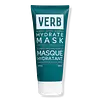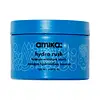What's inside
What's inside
 Key Ingredients
Key Ingredients

 Benefits
Benefits

 Concerns
Concerns

 Ingredients Side-by-side
Ingredients Side-by-side

Water
Skin ConditioningGlycerin
HumectantCetyl Alcohol
EmollientBehentrimonium Methosulfate
Dimethicone
EmollientDioctyldodecyl Dodecanedioate
EmollientOlea Europaea Fruit Oil
MaskingStearyl Alcohol
EmollientCetrimonium Chloride
AntimicrobialCetearyl Alcohol
EmollientGlycol Palmitate
EmulsifyingArgania Spinosa Kernel Oil
EmollientOrbignya Oleifera Seed Oil
EmollientCetearyl Olivate
Sorbitan Olivate
EmulsifyingCeramide NP
Skin ConditioningCeramide Ns
Skin ConditioningEthylhexylglycerin
Skin ConditioningGlucose
HumectantHydroxyethylcellulose
Emulsion StabilisingCellulose
AbsorbentQuaternium-87
CleansingBetaine
HumectantGuar Hydroxypropyltrimonium Chloride
Skin ConditioningAnhydroxylitol
HumectantXylitol
HumectantXylitylglucoside
HumectantArachidyl Glucoside
EmulsifyingPolyglyceryl-10 Pentastearate
Skin ConditioningSodium Stearoyl Lactylate
EmulsifyingParfum
MaskingCitric Acid
BufferingBehenyl Alcohol
EmollientArachidyl Alcohol
EmollientMyristyl Alcohol
EmollientSodium Acetate
BufferingPhenoxyethanol
PreservativeBenzyl Salicylate
PerfumingWater, Glycerin, Cetyl Alcohol, Behentrimonium Methosulfate, Dimethicone, Dioctyldodecyl Dodecanedioate, Olea Europaea Fruit Oil, Stearyl Alcohol, Cetrimonium Chloride, Cetearyl Alcohol, Glycol Palmitate, Argania Spinosa Kernel Oil, Orbignya Oleifera Seed Oil, Cetearyl Olivate, Sorbitan Olivate, Ceramide NP, Ceramide Ns, Ethylhexylglycerin, Glucose, Hydroxyethylcellulose, Cellulose, Quaternium-87, Betaine, Guar Hydroxypropyltrimonium Chloride, Anhydroxylitol, Xylitol, Xylitylglucoside, Arachidyl Glucoside, Polyglyceryl-10 Pentastearate, Sodium Stearoyl Lactylate, Parfum, Citric Acid, Behenyl Alcohol, Arachidyl Alcohol, Myristyl Alcohol, Sodium Acetate, Phenoxyethanol, Benzyl Salicylate
Water
Skin ConditioningCetearyl Alcohol
EmollientCetyl Alcohol
EmollientGlycerin
HumectantIsopropyl Myristate
EmollientBehentrimonium Chloride
PreservativeMyristyl Alcohol
EmollientPolyester-37
Skin ConditioningEthyl Macadamiate
Skin ConditioningHyaluronic Acid
HumectantPolyglutamic Acid
Skin ConditioningSqualane
EmollientButyrospermum Parkii Butter
Skin ConditioningBrassica Campestris Seed Oil
Skin ConditioningCocos Nucifera Oil
MaskingHippophae Rhamnoides Fruit/Seed Oil
AntimicrobialSesamum Indicum Seed Oil
EmollientSpirulina Platensis Extract
Skin ProtectingCocos Nucifera Water
MaskingEmblica Officinalis Fruit Extract
Skin ConditioningCurcuma Longa Root Extract
MaskingIsododecane
EmollientCetrimonium Chloride
AntimicrobialEthylhexylglycerin
Skin ConditioningEthyl Canolate
Skin ConditioningNeopentyl Glycol Diheptanoate
EmollientLauryl Alcohol
EmollientPanthenol
Skin ConditioningTocopheryl Acetate
AntioxidantTocopherol
AntioxidantLeuconostoc/Radish Root Ferment Filtrate
AntimicrobialGuar Hydroxypropyltrimonium Chloride
Skin ConditioningPropanediol
SolventPotassium Sorbate
PreservativeSodium Benzoate
MaskingIsopropyl Alcohol
SolventMalic Acid
BufferingCitric Acid
BufferingPhenoxyethanol
PreservativeParfum
MaskingHydroxycitronellal
PerfumingBenzyl Benzoate
AntimicrobialLimonene
PerfumingWater, Cetearyl Alcohol, Cetyl Alcohol, Glycerin, Isopropyl Myristate, Behentrimonium Chloride, Myristyl Alcohol, Polyester-37, Ethyl Macadamiate, Hyaluronic Acid, Polyglutamic Acid, Squalane, Butyrospermum Parkii Butter, Brassica Campestris Seed Oil, Cocos Nucifera Oil, Hippophae Rhamnoides Fruit/Seed Oil, Sesamum Indicum Seed Oil, Spirulina Platensis Extract, Cocos Nucifera Water, Emblica Officinalis Fruit Extract, Curcuma Longa Root Extract, Isododecane, Cetrimonium Chloride, Ethylhexylglycerin, Ethyl Canolate, Neopentyl Glycol Diheptanoate, Lauryl Alcohol, Panthenol, Tocopheryl Acetate, Tocopherol, Leuconostoc/Radish Root Ferment Filtrate, Guar Hydroxypropyltrimonium Chloride, Propanediol, Potassium Sorbate, Sodium Benzoate, Isopropyl Alcohol, Malic Acid, Citric Acid, Phenoxyethanol, Parfum, Hydroxycitronellal, Benzyl Benzoate, Limonene
 Reviews
Reviews

Ingredients Explained
These ingredients are found in both products.
Ingredients higher up in an ingredient list are typically present in a larger amount.
Cetearyl alcohol is a mixture of two fatty alcohols: cetyl alcohol and stearyl alcohol. It is mainly used as an emulsifier. Emulsifiers help prevent the separation of oils and products. Due to its composition, it can also be used to thicken a product or help create foam.
Cetearyl alcohol is an emollient. Emollients help soothe and hydrate the skin by trapping moisture.
Studies show Cetearyl alcohol is non-toxic and non-irritating. The FDA allows products labeled "alcohol-free" to have fatty alcohols.
This ingredient is usually derived from plant oils such as palm, vegetable, or coconut oils. There is debate on whether this ingredient will cause acne.
Due to the fatty acid base, this ingredient may not be Malassezia folliculitis safe.
Learn more about Cetearyl AlcoholThis ingredient is a preservative, antimicrobial, and emulsifier. It is often used in cosmetics for its ability to cleanse, condition, and reduce static.
Cetrimonium chloride is a quaternary ammonium salt, meaning it has a water-soluble structure.
Cetyl Alcohol is a fatty alcohol. Fatty Alcohols are most often used as an emollient or to thicken a product.
Its main roles are:
Though it has "alcohol" in the name, it is not related to denatured alcohol or ethyl alcohol.
The FDA allows products labeled "alcohol-free" to have fatty alcohols.
Learn more about Cetyl AlcoholCitric Acid is an alpha hydroxy acid (AHA) naturally found in citrus fruits like oranges, lemons, and limes.
Like other AHAs, citric acid can exfoliate skin by breaking down the bonds that hold dead skin cells together. This helps reveal smoother and brighter skin underneath.
However, this exfoliating effect only happens at high concentrations (20%) which can be hard to find in cosmetic products.
Due to this, citric acid is usually included in small amounts as a pH adjuster. This helps keep products slightly more acidic and compatible with skin's natural pH.
In skincare formulas, citric acid can:
While it can provide some skin benefits, research shows lactic acid and glycolic acid are generally more effective and less irritating exfoliants.
Most citric acid used in skincare today is made by fermenting sugars (usually from molasses). This synthetic version is identical to the natural citrus form but easier to stabilize and use in formulations.
Read more about some other popular AHA's here:
Learn more about Citric AcidEthylhexylglycerin (we can't pronounce this either) is commonly used as a preservative and skin softener. It is derived from glyceryl.
You might see Ethylhexylglycerin often paired with other preservatives such as phenoxyethanol. Ethylhexylglycerin has been found to increase the effectiveness of these other preservatives.
Glycerin is already naturally found in your skin. It helps moisturize and protect your skin.
A study from 2016 found glycerin to be more effective as a humectant than AHAs and hyaluronic acid.
As a humectant, it helps the skin stay hydrated by pulling moisture to your skin. The low molecular weight of glycerin allows it to pull moisture into the deeper layers of your skin.
Hydrated skin improves your skin barrier; Your skin barrier helps protect against irritants and bacteria.
Glycerin has also been found to have antimicrobial and antiviral properties. Due to these properties, glycerin is often used in wound and burn treatments.
In cosmetics, glycerin is usually derived from plants such as soybean or palm. However, it can also be sourced from animals, such as tallow or animal fat.
This ingredient is organic, colorless, odorless, and non-toxic.
Glycerin is the name for this ingredient in American English. British English uses Glycerol/Glycerine.
Learn more about GlycerinThis ingredient is derived from guar gum.
It is a conditioning ingredient, meaning it helps soften skin and hair.
Myristyl Alcohol is type of fatty alcohol. It is a white, waxy solid and insoluble in water.
As an emollient, it hydrates the skin by trapping moisture in.
Fatty Alcohols are most often used as an emollient or to thicken a product. They are usually derived from natural fats and oils and therefore do not have the same drying or irritating effect as solvent alcohols.
Learn more about Myristyl AlcoholParfum is a catch-all term for an ingredient or more that is used to give a scent to products.
Also called "fragrance", this ingredient can be a blend of hundreds of chemicals or plant oils. This means every product with "fragrance" or "parfum" in the ingredients list is a different mixture.
For instance, Habanolide is a proprietary trade name for a specific aroma chemical. When used as a fragrance ingredient in cosmetics, most aroma chemicals fall under the broad labeling category of “FRAGRANCE” or “PARFUM” according to EU and US regulations.
The term 'parfum' or 'fragrance' is not regulated in many countries. In many cases, it is up to the brand to define this term.
For instance, many brands choose to label themselves as "fragrance-free" because they are not using synthetic fragrances. However, their products may still contain ingredients such as essential oils that are considered a fragrance by INCI standards.
One example is Calendula flower extract. Calendula is an essential oil that still imparts a scent or 'fragrance'.
Depending on the blend, the ingredients in the mixture can cause allergies and sensitivities on the skin. Some ingredients that are known EU allergens include linalool and citronellol.
Parfum can also be used to mask or cover an unpleasant scent.
The bottom line is: not all fragrances/parfum/ingredients are created equally. If you are worried about fragrances, we recommend taking a closer look at an ingredient. And of course, we always recommend speaking with a professional.
Learn more about ParfumPhenoxyethanol is a preservative that has germicide, antimicrobial, and aromatic properties. Studies show that phenoxyethanol can prevent microbial growth. By itself, it has a scent that is similar to that of a rose.
It's often used in formulations along with Caprylyl Glycol to preserve the shelf life of products.
Water. It's the most common cosmetic ingredient of all. You'll usually see it at the top of ingredient lists, meaning that it makes up the largest part of the product.
So why is it so popular? Water most often acts as a solvent - this means that it helps dissolve other ingredients into the formulation.
You'll also recognize water as that liquid we all need to stay alive. If you see this, drink a glass of water. Stay hydrated!
Learn more about Water